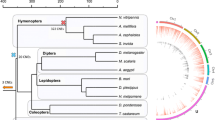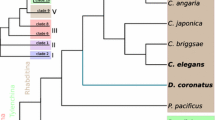Summary
The nematode,Caenorhabditis elegans, has a six-member gene family encoding vitellogenins, the yolk protein precursors. These genes are expressed exclusively in the intestine of the adult hermaphrodite. Here we report the cloning of all five members of the homologous gene family from anotherCaenorhabditis species,Caenorhabditis briggsae. Nucleotide sequence analysis of these genes reveals they are about 85% identical to theC. elegans genes in the coding regions. Oveerall similarity is much reduced in noncoding and flanking regions. However, two repeated heptamers, previously identified in the upstream regions of theC. elegans genes, are largely conserved in both location and sequence inC. briggsae. Conservation of certain of these heptamers suggests that proteins bound at these positions may be especially important to promoter function and/or regulation. Comparative sequence analysis also suggests the possibility that the first 70 bases of the vitellogenin mRNAs can be folded into stable secondary structures. Almost all base differences between the two species occur in sequences predicted to be unpaired, suggesting that the ability to form intrastrand base pairs has been selected duringCaenorhabditis evolution.
Similar content being viewed by others
References
Blumenthal T, Squire M, Kirtland S, Cane J, Donegan M, Spieth J, Sharrock WJ (1984) Cloning of a yolk protein gene family fromCaenorhabditis elegans. J Mol Biol 174:1–18
Emmons SW, Klass MR, Hirsh D (1979) Analysis of the constancy of DNA sequences during development and evolution of the nematodeCaenorhabditis elegans. Proc Natl Acad Sci USA 76:1333–1337
Frischauf A-M, Lehrach H, Polstka A, Murray NM (1983) Lambda replacement vectors carrying polylinker sequences. J Mol Biol 170:827–842.
Heine U, Blumenthal T (1986) Characterization of regions of theCaenorhabditis elegans X chromosome containing vitellogenin genes. J Mol Biol 188:301–312
Karn J, Brenner S, Barnett L, Cesareni G (1980) Novel bacteriophage lambda cloning vector. Proc Natl Acad Sci USA 77:5172–5176
Kimble J, Sharrock WJ (1983) Tissue-specific synthesis of yolk proteins inCaenorhabditis elegans. Dev Biol 96:189–196
Klein-Hitpass L, Schorpp M, Wagner U, Ryffel GU (1986) An estrogen-responsive element derived from the 5′ flanking region of theXenopus vitellogenin A2 gene functions in transfected human cells. Cell 46:1053–1061.
Lawson TG, Ray BK, Dodds JT, Grifo JA, Abramson RD, Merrick WC, Betsch DF, Weith HL, Thach RE (1986) Influence of 5′ proximal secondary structure on the translational efficiency of eukaryotic mRNAs and on their interaction with initiation factors. J Biol Chem 261:13979–13989
Maniatis T, Fritch EF, Sambrook J (1982) Molecular cloning. Cold Spring Harbor Laboratory, New York.
Nardelli D, Gerber-Huber S, van het Schip FD, Gruber M, AB G, Wahli W (1987) Vertebrate and nematode genes coding for yolk proteins are derived from a common ancestor. Biochemistry 26:6397–6402
Pustell J, Kafatos FC (1986) A convenient and adaptable microcomputer environment for DNA and protein manipulation and analysis. Nucleic Acids Res 14:479–488
Sanger F, Nicklen S, Coulson AR (1977) DNA sequencing with chain-terminating inhibitors. Proc Natl Acad Sci USA 74: 5463–5467
Spieth J, Blumenthal T (1985) TheC. elegans vitellogenin gene family includes a gene encoding a distantly related protein. Mol Cell Biol 5:2495–2501
Spieth J, Denison K, Kirtland S, Cane J, Blumenthal T (1985) TheC. elegans vitellogenin genes: short sequence repeats in the promoter regions and homology to the vertebrate genes. Nucleic Acids Res 13:5283–5295
Spieth J, Denison K, Zucker E, Blumenthal T (1986) The nucleotide sequence of a nematode vitellogenin gene. Nucleic Acids Res 13:7129–7138
Spieth J, MacMorris M, Broverman S, Greenspoon S, Blumenthal T (1988) Regulated expression of a vitellogenin fusion gene in transgenic nematodes. Dev Biol 130:285–293
Zuker M, Stiegler P (1981) Optional computer folding of large RNA sequences using thermodynamics and auxiliary information. Nucleic Acids Res 9:133–148
Author information
Authors and Affiliations
Rights and permissions
About this article
Cite this article
Zucker-Aprison, E., Blumenthal, T. Potential regulatory elements of nematode vitellogenin genes revealed by interspecies sequence comparison. J Mol Evol 28, 487–496 (1989). https://doi.org/10.1007/BF02602929
Issue Date:
DOI: https://doi.org/10.1007/BF02602929




